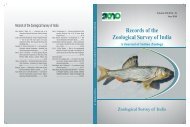checklist of bot flies (insecta: diptera: oestridae) - Zoological Survey ...
checklist of bot flies (insecta: diptera: oestridae) - Zoological Survey ...
checklist of bot flies (insecta: diptera: oestridae) - Zoological Survey ...
Create successful ePaper yourself
Turn your PDF publications into a flip-book with our unique Google optimized e-Paper software.
CHECKLIST OF BOT FLIES (INSECTA: DIPTERA: OESTRIDAE) FROM INDIA<br />
DHRITI BANERJEE AND KAUSHIK KR. BHATTACHARYA<br />
<strong>Zoological</strong> <strong>Survey</strong> <strong>of</strong> India, M-Block, New Alipore, Kolkata-700053.<br />
e-mail: dhritibanerjee@gmail.com<br />
Gasterophilus intestinalis (De Geer, 1776)<br />
Botfly larva dorsal view<br />
Anterior end showing<br />
cephalopharyngeal skeleton<br />
Botfly larva ventral view<br />
Posterior end showing caudal<br />
spines<br />
Botfly (Oestrus ovis Linn.1758) larvae collected from the human conjunctiva <strong>of</strong> a patient with ophthalmomyiasis<br />
externa *<br />
*Photograph courtesy: Dr. Pankaj Choudhury, Deptt <strong>of</strong> Opthalmology, S.S Medical College, Rewa, Madhya Pradesh.
INTRODUCTION<br />
A <strong>bot</strong> fly belongs to the family Oestridae within the superfamily Oestroidea, variously known as<br />
warble <strong>flies</strong>, heel <strong>flies</strong>, and gad<strong>flies</strong>. The <strong>bot</strong> <strong>flies</strong> have received considerable attention ever since<br />
the domestication <strong>of</strong> the ho<strong>of</strong>ed animals. The <strong>flies</strong> are parasitic and are <strong>of</strong> significant medical<br />
and veterinary importance because <strong>of</strong> their mammal-parasitising habit. The larvae grow in the<br />
skin, flesh, nasal, ophthalmic and alimentary tracts <strong>of</strong> cattle, horses, sheep and goat. The<br />
Oestridae accounts for 5% <strong>of</strong> the cases <strong>of</strong> all human myasis. The human <strong>bot</strong>fly, Dermatobia<br />
hominis, is the only species <strong>of</strong> <strong>bot</strong> fly known to use humans routinely as its larval host, while<br />
others may accidentally invade the human hosts living in close approximation to cattle.<br />
There are 130 known species <strong>of</strong> <strong>bot</strong> <strong>flies</strong> under 26 genera worldwide. 13 species (<strong>of</strong> which two<br />
are endemic *) belonging to 10 genera under 3 subfamilies Gasterophilinae, Hypodermatinae<br />
and Oestrinae have been reported from India.<br />
Genus Gasterophilus Leach, 1817<br />
ORDER: DIPTERA<br />
SUBORDER: CYCLORRHAPHA<br />
SUPERFAMILY: OESTROIDEA<br />
FAMILY OESTRIDAE<br />
Subfamily GASTEROPHILINAE<br />
1. Gasterophilus haemorrhoidalis (Linnaeus, 1758)<br />
2. Gasterophilus intestinalis (De Geer, 1776)<br />
3. Gasterophilus nasalis (Linnaeus, 1758)<br />
4. Gasterophilus pecorum (Fabricius, 1794)<br />
Genus Gyrostigma Brauer, 1884<br />
5. Gyrostigma sumatrensis Brauer, 1887<br />
Genus Cobboldia Brauer, 1887<br />
6. Cobboldia elephantis (Cobbold, 1882)*<br />
Genus Hypoderma Latreille, 1818<br />
7. Hypoderma lineatum (Villers, 1789)<br />
Genus Portschinskia Semenov, 1902<br />
Subfamily HYPODERMATINAE<br />
8. Portschinskia himalayana Grunin, 1962*
Genus Przhevalskiana Grunin, 1948<br />
9. Przhevalskiana sileneus (Brauer, 1858)<br />
Genus Cephalopina Strand, 1928<br />
10. Cephalopina titillator (Clark, 1816)<br />
Genus Oestromyia Brauer, 1860<br />
11. Oestromyia leporina (Pallas, 1778)<br />
Genus Oestrus Linnaeus, 1758<br />
12. Oestrus ovis (Linnaeus, 1758)<br />
Genus Rhinoestrus Brauer, 1886<br />
13. Rhinoestrus purpureus (Brauer, 1858)<br />
Subfamily OESTRINAE<br />
REFERENCES<br />
Bisby F., Roskov Y., Culham A., Orrell T., Nicolson D., Paglinawan L., Bailley N., Appeltans W.,<br />
Kirk P., Bourgoin T., Baillargeon G., Ouvrard D., eds. (2012) In: Species 2000 & ITIS Catalogue <strong>of</strong><br />
Life, 2012 Annual Checklist .DVD; Species 2000:Reading,U.K.<br />
Colwell, D.D., Hall, M.J., Scholl, P.J., (Ed). 2006. The Oestrid Flies Biology, Host-Parasite<br />
Relationships Impact and Management. Pg. 1-376, CABI.<br />
Delfinado, M.D. and Hardy, D.E. 1977. Catalogue <strong>of</strong> the Diptera <strong>of</strong> the Oriental Region. The<br />
University Press <strong>of</strong> Hawaii, Honolulu, 3: 698-702.<br />
Evenhuis, N.L., Pape, T., Pont, A.C. and Thompson, F. C. 2008. Biosystematic Database <strong>of</strong> World<br />
Diptera, Version 11,http://www.<strong>diptera</strong>.org/biosys.htm.<br />
Pape, T. 2001. “Phylogeny <strong>of</strong> Oestridae (Insecta: Diptera)”. Systematic Entomology, 26(2):133-<br />
171.<br />
Pape, T. & Thomson, F.C. (eds) 2012. Systema Dipterorum (version 2.0, Jan 2011). In: Species<br />
2000 & ITIS Catalogue <strong>of</strong> Life, 2012 Annual Checklist (Bisby F., Roskov Y., Culham A., Orrell T.,<br />
Nicolson D., Paglinawan L., Bailley N., Appeltans W., Kirk P., Bourgoin T., Baillargeon G., Ouvrard<br />
D., eds).<br />
********
















